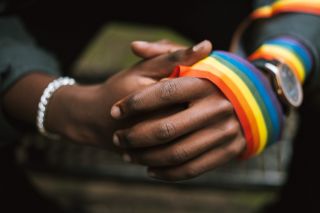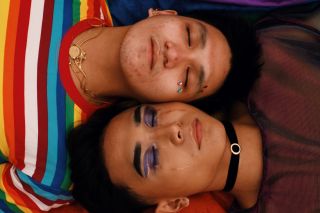Gender
5 Unconscious Biases to Unlearn about Non-Binary People
Non-binary people transcend taken-for-granted cultural and social expectations.
Updated April 24, 2024 Reviewed by Vanessa Lancaster
Key points
- The "transgender umbrella" includes binary and non-binary trans folks. Both face similar and different biases.
- Non-binary people may embrace femininity or masculinity equally, to varying degrees, or not at all.
- Holistically comprehending non-binary person's identity entails more than not "misgendering" their pronouns.

Nearly half of the non-binary workers in the U.S. endure employee discrimination at least monthly, a mere one-third feel comfortable “coming out” at work, and over thirty percent report bias in the hiring process alone.
Thankfully, the Equal Employment Opportunity Commission (EEOC) is now considering tracking workforce data on non-binary employees. Last year they announced an updated discrimination charge intake form that includes a gender option for non-binary people.
Yet, institutionalizing acknowledgment of transgender people on applications, forms, and surveys is still a proposition many workplaces and public institutions consider radical, even unthinkable.
The few national polls geared toward non-binary, trans folx — which all illustrate a correlation between structural cisgenderism/transphobia and disproportionate rates of homelessness, incarceration, overdoses, suicides, and sexual exploitation — have been disseminated almost exclusively by transgender advocacy groups.
Despite limited data and research, non-binary folx — an estimated 1.2 million in the U.S. — have collectively mobilized their political power and resisted censorship and erasure.
Fourteen states now offer a "non-binary" option for birth certificates, twenty states and the District of Columbia allow a "non-binary" identifier (e.g., X) on driver’s licenses, thirty-five percent of Gen Z knows someone who uses gender-neutral pronouns, and one in four LGBTQ+ youth identifies as non-binary (although non-binary gender identity is distinct from sexual orientation).
For newcomers to this conversation, the “transgender umbrella” encompasses binary and non-binary trans folx.
Many binary trans folx — not all — seek to transition into the traditional cultural norms and social expectations associated with the biological sex deemed “opposite” of their assigned sex (note: absolutist rhetoric like “there are only two sexes” erases intersex people and the vast range of sex hormone levels across males and females).
Non-binary, trans folx, on the other hand, may not identify with femininity/femaleness or masculinity/maleness — or they may embrace both, equally or to varying degrees. Even as gender expansiveness becomes more de-stigmatized, many non-binary folx still declare themselves distinct from cisgender people.
To be sure, neither gender fluidity nor gender nonconformity suggests an identity crisis or “confusion.”

Since 2020, this type of propaganda has emboldened countless school boards to ban library books with trans characters and state legislatures to propose 494 anti-trans bills in 2023 alone. And recently, state lawmakers in Texas, South Carolina, Missouri, Iowa, and Florida have proposed banning DEI initiatives at public colleges and universities — a move that would greatly undermine the well-being of all trans students.
Resources like this one, intended to humanize non-binary folx and combat disinformation, are crucial amidst an increasingly anti-trans political climate. The overall situation is dire, and dismantling cisnormativity and transphobia will require all hands on deck. Yet, as the title suggests, solidarity entails deep cultural humility — so here are five unconscious biases to keep in mind as you embark upon self-reflecting and unlearning.
1. Not all non-binary individuals are teenagers or twenty-somethings.
Ageism is arguably the most common way cisgender people invalidate nonbinary folx of all ages. That often looks like dismissing non-binary identity, history and culture as “new age” — instead of honoring that non-binary folx have always existed but only recently attained the media visibility and political solidarity to make an undeniable mark on mainstream society.
Growing up in a society that is less repressive — and less complacent about condemning willful ignorance — is the main reason why younger people are more willing to openly identify as non-binary. They are included, not indoctrinated, and inclusion fosters self-affirmation and self-worth.
If the increasing visibility of young non-binary people seems suspicious, consider how transphobia silenced or killed so many of their non-binary elders who could have caught you up to speed before now.

2. Not all non-binary people are academics or activists.
Initial bewilderment about trans folx is to be expected — we do not know what we do not know. Ignorance should have an expiration date, though.
It is not OK, however, for cis folks’ default reaction to continue being judgmental rather than curious.
This often looks like defensiveness that pathologizes and “others” non-binary people as a monolithic group of raging activists or ungrounded academics who are out of touch with “everyday people” — as if non-binary people are not everyday people, too. It also plays right into fear-mongering “world domination” conspiracies about trans people allegedly seeking to indoctrinate the masses.
3. Not all non-binary people prioritize gender-neutral pronouns and greetings.
Most non-binary people I know are not offended by forgetful and innocent misgendering. Yet, there still exists a powerful trope that all non-binary folx will give a “fierce” or “sassy” response when others misgender them with pronouns or greetings.
In academe, especially, this stereotype is often fueled by cis folks’ paranoia about call-outs. What cis folks must remember is that navigating the world as trans can confer a double consciousness, to invoke DuBois. The ability to “read” cis people means the difference between deliberate antagonism and innocent slip-ups is crystal clear. In a world of ubiquitous invalidation, even fumbled effort is noted.
Equally important to remember is the fact that non-binary people are not a monolith. We would be remiss to assume that any two non-binary individuals prioritize pronouns to the exact same degree. For some, the desire to be comprehended as non-binary in a holistic way supersedes nomenclature. For others, [re]naming themselves is a source of agency and self-regard in and of itself.
Either way, an apology backed up by better effort next time is sufficient when you fumble— no need to make anyone uncomfortable by harping on innocent mistakes.

4. Not all non-binary people look androgynous or genderless.
Looking legibly androgynous for the cisgender gaze is not a prerequisite for being non- binary — this type of gender-policing precludes non-binary folx from self-definition and allows cis people to continue defining reality to a hegemonic degree that reifies cisnormativity.
Self–definition is important because potential violence is the reason why many non-binary people are reluctant to appear visibly trans. And although concealment can feel self-protective, it can also result in cognitive dissonance (like code-switching) in the form of gender dysphoria.
Cisgender privilege can cause some cisgender people to oversimplify these nuances and rely upon their own limited perception as a barometer of identity politics and ideological purity.
5. Not all non-binary people feel at home in feminist and queer spaces.
The weaponization of tears and essentialist ideas about female fragility is not uncommon among cisgender feminists who dodge accountability for cissexism and trans-exclusionary radical feminism, or TERF ideology.
These feminists often fight patriarchy by romanticizing womanhood in ways that biologize and essentialize social constructions of gender, rather than focusing on ways to exist beyond colonial cis-heteropatriarchy. Renowned authors J.K. Rowling, Chimamanda Ngozi Adichie, and Alice Walker, are just a few examples of pioneering feminists whose TERF ideology has left the trans (and queer) community feeling betrayed.

Relatedly, is it not unheard of for cisgender queer activists to play into cis-normative respectability politics — “gay men are strong just like straight men,” “lesbians want families just like straight couples” and so forth. They attempt to reap incremental gains that fall short of affirming trans people, then blame trans people for not being grateful and patient.
Such intra-community tensions offer valuable lessons on trans-inclusion for campus LGBTQ centers and women’s centers — do not assume liberation framed by identity politics will feel inviting to folx on the trans spectrum of experience. Trans-inclusion requires us to address cissexism intentionally and directly.
If you or someone you love is contemplating suicide, seek help immediately. For help 24/7, dial 988 for the National Suicide Prevention Lifeline, or reach out to the Crisis Text Line by texting TALK to 741741. To find a therapist, visit the Psychology Today Therapy Directory.
References
Gibson, S., & Fernandez, J. (2018). Gender Diversity and Non-Binary Inclusion in the Workplace: The Essential Guide for Employers. London: Jessica Kingsley.
Grant, Jaime M., Lisa A. Mottet, Justin Tanis, Jack Harrison, Jody L. Herman, and Mara Keisling. Injustice at Every Turn: A Report of the National Transgender Discrimination Survey. Washington: National Center for Transgender Equality and National Gay and Lesbian Task Force, 2015.
Fernandez, J., Gibson, S. and Twist, J. (2017) Non-Binary Workplace and Customer Experience Survey. Beyond the Binary.




